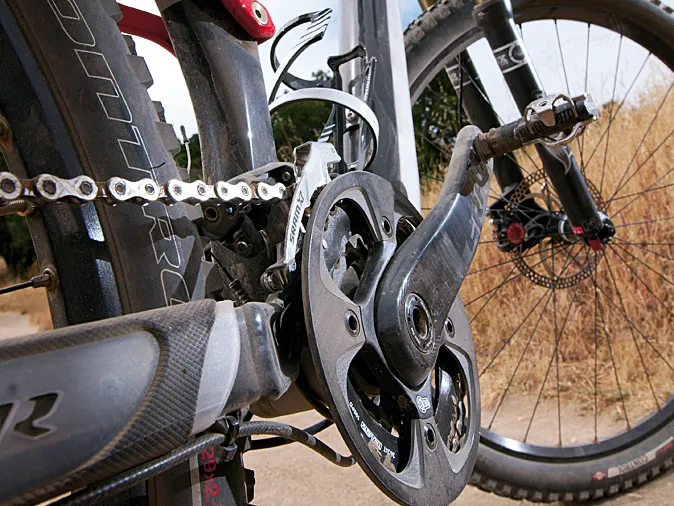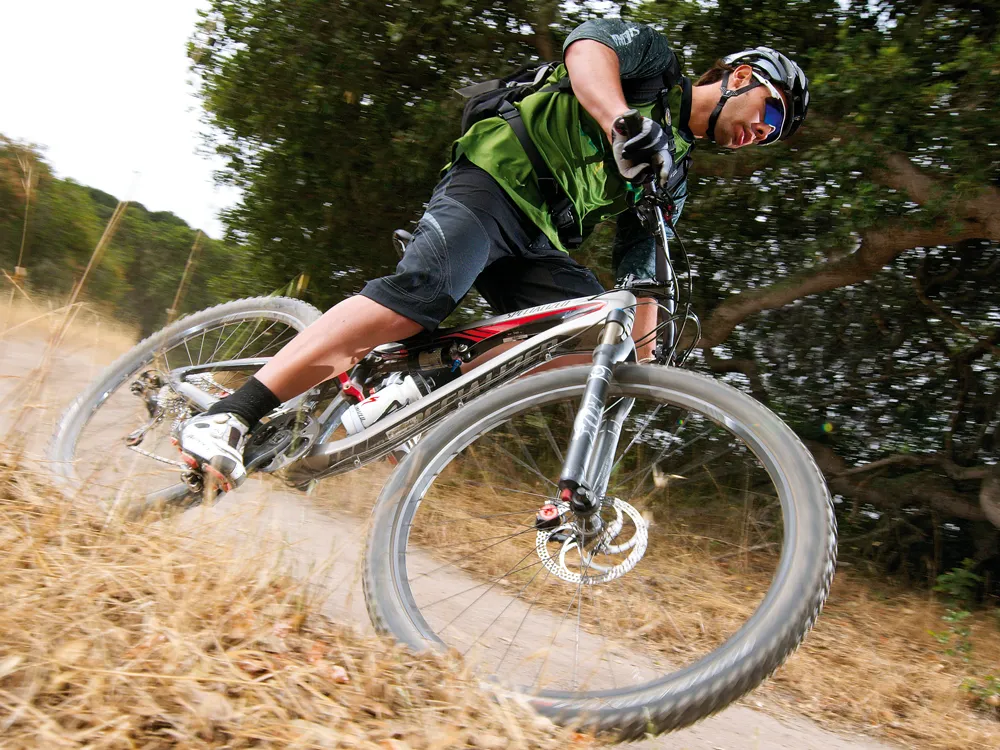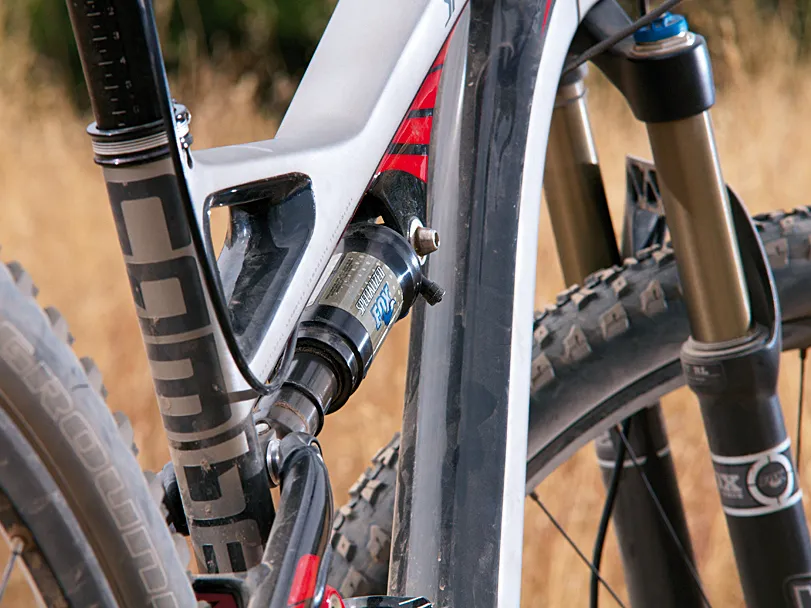It’s not often that a new bike becomes an instant hit, but Specialized’s new-for-2011 Camber was barely out of the starting blocks when it became a mainstay of the range. Slotting neatly between the race-orientated 100mm-travel Epic and the boulder-swallowing 140mm Stumpjumper (and 150mm EVO), it was always going to be a crucial bike for the company that kick-started mountain bike mass production back in the 1980s.
The Camber has been so successful that the range gets a big boost for 2012 with the introduction of 29er wheels – as an alternative to the 26in ‘regular’ version – and a new carbon chassis for the bigger wheels only. Frankly, we were sceptical that a big-wheeled Camber would work. Specialized's own designers admit that the advantages of bigger wheels become less clear cut as travel increases. Not only have we been proved wrong, but we may actually prefer the 29er Camber to the regular version.
Aggressive riders may prefer the flickablility of the 26in Camber but for long rides out in big country, the smooth ease of the 29er makes perfect sense. The vibration reduction, torsional rigidity and low weight of the carbon front triangle make it well worth the extra if you can justify the outlay. Our only reservation is over mud clearance – mud pluggers beware.
Ride & handling: Big-wheel easy rolling and carbon comfort
Although the Camber was late to the 120mm party in 2011, it’s a credit to Specialized’s engineers that it moved straight to the top of the mid-travel pack. The 26in-wheeled version’s reasonable weight, relaxed geometry and apparently bottomless travel make it a versatile and fun trail companion. It’s fair to say that the carbon 29er version has a lot to live up to.
The good news is that, with a couple of years of very intensive development under their belt, it’s clear that Specialized have got 29er geometry dialled. Getting the big wheels to behave in fast-changing situations on the trail has been a big priority for the engineers. Even with the greater demands of the Camber’s mid-travel format, the only perceptible big wheel-related foible is a subtly less ‘flickable’ feel to the front end compared with the 26in version.
You have to work a bit harder to push and pull the front wheel in and out of tight, quick-changing lines – but that’s a comment that applies to pretty much any 29er we’ve ever ridden. It’s a characteristic rather than a criticism. The flipside – and the big advantage of 29ers – is a noticeable reduction in jitteriness and stalling over small to middling sized trail obstacles.
The Camber 29 rolls over rain gullies, rocks, roots and water bars as though they’re not there, the large wheels doing what large wheels do and plenty of travel taking care of the rest. The 29er platform may lose a few mm of travel over the 26in version but, in practice, it’s simply not noticeable. If anything, it’s smoother and faster.
The icing on the cake is the low weight, incredible stiffness and vibration-absorbing character of the carbon front triangle. Few 29ers steer with the precision of the Camber Carbon 29, while the combination of big wheel easy rolling and carbon comfort makes perfect sense for long days in the saddle.

Frame & equipment: Flowing lines and organic tube shapes
Building a 29er version of the Camber represents a shift of focus for Specialized. 2011 marked the company’s first concerted push into big wheel territory, but there was a clear division between wheel sizes and travel. What a difference a year makes. US riders can now choose big wheel options all the way up to the rock-spitting Stumpjumper EVO. In the UK the Camber will be the longest travel big-wheeler in the range, which makes more sense to us. Big wheels are all about flow. Smaller wheels are easier to throw around. Huge travel with big wheels just doesn’t add up for the vast majority of UK trail riding. Probably.
Don’t expect the same travel as the 26in version, though. Moving up to big wheels creates engineering headaches related to tyre clearances and geometry, some of which can be eased by reducing travel a tad. Given that one of the qualities of big wheels is that they roll more easily over trail obstacles, it’s no great loss. So the 26in Camber has 120mm travel at each end, whereas the 29er features 110mm at the back and 100mm up front. For big wheels, that’s plenty.
The front triangle is made from Specialized’s proprietary FACT (Functional Advanced Composite Technology) 9M carbon. Flowing lines and organic tube shapes suit the carbon build, though at a distance you’d be hard pressed to spot the differences from the very similar looking aluminium 29er chassis. There’s internal cable routing for Specialized’s Command Post adjustable seatpost. It may seem out of place on a big-wheeler, but the three preset positions are useful in everyday trail riding.
The clever self-adjusting Autosag shocks featured on 2012 Stumpjumpers haven’t found their way onto the Camber range, but the Expert’s Fox Triad shock is as competent and easy to set up as you’d expect, as well as the perfect complement to the Fox Float 32 – with 29er specific geometry – plugged into the front. Bolted onto the back and providing 110mm of rear wheel travel is an aluminium rear triangle built from Specialized’s own high-end M5 alloy.
It’s a feat of engineering to have crammed relatively short chainstays, a 29in wheel and 110mm travel into the space, but it’s here that the most obvious compromise is clearly visible: very tight clearances between tyre and seatstays. It’s unlikely that the Camber 29er will be the best option for mud-plugging duties, though the dry California dust of our test sessions didn’t give us the opportunity to find out.
A 142mm bolt-through rear axle provides plenty of extra torsional rigidity and wheel strength, while Specialized’s designers have also put extra time and effort into increasing the rigidity of the larger diameter wheels. A 2x10 SRAM X0-based transmission provides snappily reliable shifting, low weight and stacks of ground clearance, delivering power to the completely redesigned Ground Control rear tyre.

This article was originally published in What Mountain Bike magazine.


